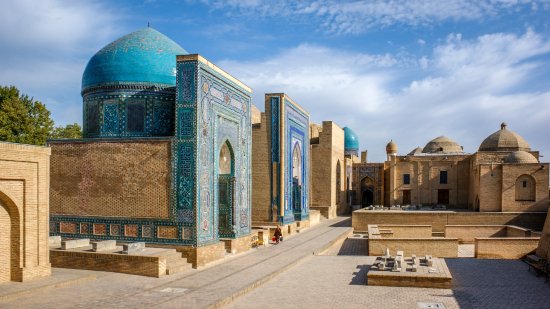Shah-i-Zinda Necropolis, Samarkand-Uzbekistan

The name of ensemble “Shahi-Zinda” – “the Living King” is connected with the burial complex, where the cousin of the Prophet Muhammad – Kussam ibn Abbas was buried.
The mausoleum, built in the middle of 11th century over this grave, served as the core of Shahi Zinda necropolis. Subsequently, during the reign of Amir Timur, Mirzo Ulugbek and other Timurids, the mausoleums and other religious buildings were constructed, forming the structure of the necropolis.
A unique ensemble of ancient tombs (1370-1449 years) is located near Afrasiab settlement. It is also called “Street cemetery”. Building of mosques and mausoleums of XI-XV centuries oddly stretched on both sides and their blue domes look like an elegant necklace from the top.
The ensemble’s oldest core – Kussam ibn Abbas complex (11c) appeared on the territory of the current settlement of Afrosiab, in its southern part, which was densely populated before the conquest of Samarkand by Chenghis Khan. During Timur’s reign the complex was reconstructed back. Filling with new elements continued until the 19th century. The door made of elm wood, leading to the complex, was made by craftsman Yusuf Sherazi in 1403-1405. A beautiful two-plane carving remained on the doors; the ivory inlay remained in some places. A quote on the door says that the gates of heaven are wide open for people. The large mosaic panel above the doors is another quote: “And the Prophet said: Kussam ibn Abbas more than any other man resembles me in face and character.”
“Northern Courtyard” – Shahi – Zinda
There is the “Northern Courtyard” near the complex of Kussam ibn Abbas. It includes:
– the mausoleum of Khoja Ahmad (40s of the XIV century) – which constrains the necropolis on the north.
– The unknown mausoleum dated with 1361 on the east.
Both of these mausoleums are portal-domed buildings. They are decorated in accordance with carved glazed terracotta.
On the west side, the “Northern Yard” closes the complex of Tuman-Aga, Timur’s youngest wife, built in the late XIV – early XV centuries. This complex is significantly differs in decor and in form from the previous mausoleums.
The color palette is much wider. The facade is made using carved mosaic technique. It harmoniously contrasts with the design of the mausoleum inside, where wall paintings with the image of paradise gardens are used.
The “middle” part of the ensemble
The “middle” part of the ensemble remained the outlines of the city block streets, which existed here before the Mongol invasion. “Shadi Mulk-aga” mausoleum is called as the pearl of “Shahi- Zinda” ensemble. It was built in 1372 under the order of Timur’s sister, Turkan-aga. They built this mausoleum for her daughter, who died timelessly. A quote framing the entrance reads: “That is the garden where the treasure of the world is buried. That is the tomb, in which the pearl was lost; here lies the one whose figure is similar to the figure of a cypress”.
The architectural decor is fabulously rich: carved glazed terracotta, double color majolica and small glazed bricks, epigraph, islimi and geometric ornament also present. The achievements of local ceramic craftsmen are widely expressed in the decoration of this mausoleum.
The mausoleum of Shirin Bek-aga was built for the sister of Timur in 1385- 1386. This is the earliest mausoleum from those maintained in the necropolis where carved typesetting mosaics were used in the design of the exterior. The interior is graceful and spacious. The light penetrated the mausoleum through colored glass inserted into elegant lattices – panjara.
The historical, cultural and artistic value of the ensemble lies in the fact that Shahi Zinda gives us information on the development of architecture and monumental and decorative art over several centuries.






